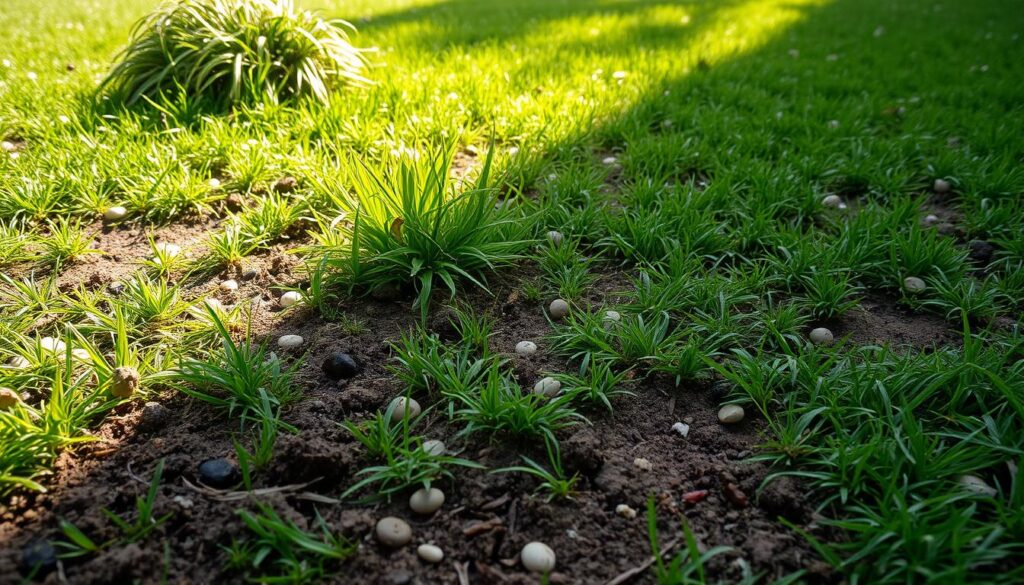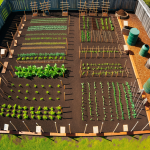As I get ready for the new growing season, I often think about the best grass seed for overseeding in spring. Can I just scatter grass seed on my lawn, or is there a better way? When is the best time to overseed my lawn in the spring for the best results? These questions are key to a successful spring overseeding.
Spring overseeding is great for filling in bare spots and making the lawn look fuller and greener. In this article, I’ll look into the best grass seed for overseeding in spring. I’ll cover the benefits, the best time to do it, and some tips for a successful overseeding. These are all important for keeping your lawn healthy and looking good.
Key Takeaways
- Spring overseeding is an effective way to improve lawn density and color.
- Choosing the right grass seed for overseeding is key for success.
- Knowing when to overseed in spring is important for the best results.
- Good lawn care and maintenance are vital for a healthy lawn.
- Overseeding in spring can help fill in bare spots and stop weeds.
- Using high-quality grass seed with a germination rate over 75% is recommended.
Understanding Spring Overseeding Basics
Exploring spring overseeding, I’ve learned its value. It fills in bare spots and boosts lawn color. Knowing when to overseed is key. Late spring is best for warm-season grasses, while cool-season lawns do well in late summer.
Success in overseeding depends on grass type and climate. Cool-season grasses do well in spring or fall, with fall being better. Warm-season grasses need late spring or early summer when it’s warm.
Important overseeding factors include:
- Soil temperatures: between 50 and 65 degrees Fahrenheit for cool-season grass and between 70 and 90 degrees Fahrenheit for warm-season grass
- Soil pH: between 6.2 and 7.0 for optimal grass seed germination
- Grass type: cool-season grasses like Kentucky bluegrass, perennial ryegrass, and fescues, or warm-season grasses like Bermudagrass, Zoysiagrass, and centipedegrass
Understanding overseeding basics and timing helps homeowners achieve a lush lawn. Spring overseeding can greatly enhance lawn health and look.
| Grass Type | Ideal Overseeding Time | Soil Temperature |
|---|---|---|
| Cool-season grass | Spring or fall | 50-65°F |
| Warm-season grass | Late spring or early summer | 70-90°F |
Top Grass Seed Varieties for Spring Overseeding
Choosing the right grass seed for spring overseeding is key for a lush lawn. The best seed depends on climate, soil, and lawn use. Popular options include perennial ryegrass, Kentucky bluegrass, and tall fescue.
These seeds are easy to grow and keep up. Perennial ryegrass grows fast, while Kentucky bluegrass has a dark green color. Tall fescue is durable and easy to care for.
Scotts Turf Builder Grass Seed Sun & Shade Mix is a top choice. It covers up to 960 square feet per 2.4-pound bag. Pennington Smart Seed Sun and Shade Tall Fescue covers up to 1,000 square feet per 4-pound bag.
Consider drought, traffic, and shade tolerance when picking a seed. Pennington Smart Seed Tall Fescue is great for dry areas. Scotts Kentucky Bluegrass Mix is disease-resistant but less pest-tolerant.
Choosing the right seed is key for a healthy lawn. Select a quality seed that fits your needs. With the right seed and care, your lawn will be lush and green for years.
| Grass Seed Variety | Coverage | Germination Time |
|---|---|---|
| Scotts Turf Builder Grass Seed Sun & Shade Mix | Up to 960 square feet per 2.4-pound bag | 10-15 days |
| Pennington Smart Seed Sun and Shade Tall Fescue | Up to 1,000 square feet per 4-pound bag | 7-10 days |
| Pennington Tifblair Centipede Grass Seed | Up to 5,000 square feet per 5-pound bag | 14-21 days |
How Weather Conditions Affect Spring Overseeding Success
Weather conditions are key to a successful spring overseeding. Temperature, rainfall, and soil temperature are important. For example, tall fescue seeds need soil temperatures between 50-65°F to germinate. Air temperatures should be between 68°F and 77°F for growth.
Knowing these weather conditions is vital for success. Temperature requirements differ by grass type, but most prefer 60°F to 80°F. Also, enough rain or water is needed for seeds to grow. Avoid overseeding in bad weather or using poor-quality seeds.
- Maintaining soil pH between 6.0 and 7.0 for optimal tall fescue growth
- Watering to keep the top inch of soil consistently moist, specially in the first weeks after planting
- Regular mowing height at 2 to 3 inches to promote deep root growth
By considering these factors and the weather’s impact, you can boost your overseeding success. This will help you get a healthy, lush lawn.
Premium Grass Seed Options for Different Regions
Choosing the right premium grass seed for your area is key for spring overseeding. Each region has its own climate and soil. Picking a grass seed that fits your area ensures a lush lawn.
Cool-season grasses like perennial ryegrass and Kentucky bluegrass are great for northern regions. Warm-season grasses like Bermudagrass and zoysiagrass are better for southern regions.
In the transition zone, a mix of both cool-season and warm-season grasses works well. Some top premium grass seed picks for different regions are:
- Blue Ribbon Kentucky Bluegrass Blend
- Velvet Blue Blend
- Northeast Seed Blend
- Northwest Seed Blend
Think about sunlight, soil type, and watering needs when picking a premium grass seed. The right seed and spring overseeding methods will give you a stunning lawn.
| Grass Seed Blend | Seeding Rate (lbs./acre) |
|---|---|
| Blue Ribbon Kentucky Bluegrass Blend | 218 |
| Velvet Blue Blend | 131 |
| Northeast Seed Blend | 131 |
| Northwest Seed Blend | 349 |
Fast-Growing Grass Seed Varieties for Quick Results
Fast-growing grass seed varieties are perfect for quick results with spring overseeding. They grow fast and make your lawn look lush and green quickly. Popular types include perennial ryegrass, fine fescue, and tall fescue.
Perennial ryegrass grows the fastest, germinating in 4-7 days. Fine fescue and tall fescue take about 7-10 days. These seeds are great for spring overseeding because they grow well in cooler weather.
These grass seed varieties are also easy to care for. They can handle some drought and grow well in different soils. But, remember to think about how well they handle foot traffic and diseases when choosing.
| Grass Seed Variety | Germination Rate | Mowing Height |
|---|---|---|
| Perennial Ryegrass | 4-7 days | 2-3 inches |
| Fine Fescue | 7-10 days | 1.5-3 inches |
| Tall Fescue | 5-10 days | 2-4 inches |
Choosing the right fast-growing grass seed variety for spring overseeding can give you quick results. You’ll have a lush, green lawn in no time.
Common Mistakes to Avoid When Overseeding
Spring overseeding is key to a lush, green lawn. But, avoiding common mistakes is essential. One big mistake is not preparing the soil right. This can make it hard for seeds to grow.
Another mistake is overseeding when it’s too hot or cold. This stress can hurt the new seedlings.
Other mistakes include:
- Using low-quality grass seed that may not be suitable for your climate or soil type
- Overseeding too heavily, which can lead to overcrowding and reduced grass health
- Failing to water properly, which can result in poor germination or seedling survival
To avoid these mistakes and get a great lawn, follow best practices. Spring overseeding needs careful planning and attention.
| Mistake | Consequence |
|---|---|
| Overseeding in extreme weather | Reduced seedling survival |
| Using low-quality grass seed | Poor germination rates |
| Overseeding too heavily | Overcrowding and reduced grass health |
Proper Soil Preparation Techniques
When preparing soil for overseeding, several factors are key. One question is whether to use straw to cover the seed. The answer depends on your lawn’s conditions. Also, can you put grass seed on dead grass? Yes, but you need to prepare the soil first.
First, test your soil to know its pH and nutrient levels. This helps choose the right grass seed and fertilizers. Also, aerating your soil is vital. It improves drainage, reduces compaction, and helps roots grow well.
Soil Testing Methods
There are many ways to test your soil, like DIY kits or lab analysis. The results show your soil’s pH, nutrient needs, and more. This info is key for grass growth.
Aeration Benefits
Aeration makes holes in the soil to let air, water, and nutrients in. You can rent a core aerator at most garden stores. It loosens the soil and removes thatch, helping seeds grow better.
Topsoil Requirements
The right topsoil depth for overseeding depends on your grass and climate. Aim for 2-4 inches of topsoil. Also, think about soil temperature and moisture for spring overseeding.
By using these soil preparation steps, you can make your lawn perfect for growth. Consider timing, soil temperature, and moisture for the best results.
| Soil Preparation Step | Importance |
|---|---|
| Soil Testing | Determines pH level and nutrient content |
| Aeration | Improves soil drainage and reduces compaction |
| Topsoil Application | Provides ideal depth for seed germination |
Best Tools and Equipment for Overseeding
For spring overseeding, the right tools are key. The size and type of lawn determine the best tools. Small lawns might need a handheld seeder or spreader. Larger lawns might require a broadcast spreader or aerator.
Popular choices include the Scotts® Whirl™ Hand-Powered Spreader for small areas. For bigger lawns, the Scotts® Turf Builder® EdgeGuard® DLX Broadcast Spreader is a good pick. Remember, seed type and climate also play a role in choosing the right tools.
Using the right overseeding equipment leads to a lush, green lawn. Investing in the best tools helps homeowners get professional results without spending too much.
- Seed type and climate
- Lawn size and type
- Personal preference and budget
Choosing the right best tools and overseeding equipment ensures a beautiful lawn all season. Take the time to pick wisely for a healthy, green lawn.
Watering Techniques for Newly Overseeded Lawns
When it comes to spring overseeding, the right watering techniques are key. To help new seeds grow, keep the top ½ inch of soil moist for 2-3 weeks. Water the lawn often, aiming for 3 times a day for 7-10 minutes each in the first week.
As the new grass grows roots, you can water less. By weeks 3 through 5, you can water once a day or every other day. Watch for signs of too much water, like puddles, and adjust your schedule.
Here are some tips for watering techniques for newly overseeded lawns:
- Water in the early morning to reduce evaporation and prevent fungus
- Keep the soil moist but not too wet
- Change your watering schedule with the weather, like after rain or when it’s very hot
By using these watering techniques and adjusting as needed, you can help your spring overseeding succeed. You’ll end up with a healthy, lush lawn.
| Weeks After Overseeding | Watering Frequency | Watering Duration |
|---|---|---|
| 1-2 | 3 times a day | 7-10 minutes |
| 3-5 | Once a day or every other day | 10-15 minutes |
| 6-8 | Deep watering every 3 days | 15-20 minutes |
Post-Overseeding Care and Maintenance
After overseeding your lawn in spring, it’s key to focus on care and maintenance. This ensures your lawn stays healthy and looks great. Regular mowing, fertilizing, and pest control are important. Mow your lawn when the new grass is three to four inches tall.
Keeping your lawn well-maintained is vital during this time. Avoid walking on the lawn for at least two weeks after seeding. This lets the new seeds grow strong. Use a starter fertilizer right after seeding, and again in four to six weeks.
Here are some key tips for post-overseeding care:
- Water the lawn two to three times daily for the first two weeks, then reduce to once a day.
- Maintain soil moisture, keeping it moist but not overly wet.
- Apply a slow-release starter fertilizer to provide consistent nutrients and reduce fertilizer burn risk.
- Minimize foot traffic for at least two weeks post-seeding.
By following these guidelines and keeping up with lawn care, your overseeded lawn will stay healthy and look great. Remember, proper care after overseeding is key to its success.
For a newly overseeded lawn, patience is essential. Let the seeds germinate and grow. With the right care, your lawn will soon be lush and vibrant.
| Weeks After Overseeding | Watering Frequency | Mowing Height |
|---|---|---|
| 1-2 | 2-3 times daily | Not recommended |
| 3-4 | 1-2 times daily | 3-4 inches |
| 5-6 | 1 time daily | 3-4 inches |
Cost Analysis of Different Grass Seed Options
Choosing the right grass seed for spring overseeding can be tough, mainly because of the cost. It’s key to do a detailed cost analysis to make a smart choice. The price of grass seed changes a lot, based on the type and quality.
Some grass seed options are cheaper, like perennial ryegrass and tall fescue. They give good results but cost less. Yet, premium seeds like Kentucky bluegrass and Bermudagrass might last longer and perform better but cost more. Think about the long-term value when picking a seed, including how much care it needs and how well it handles drought.
Here are some important things to think about when looking at the cost of different grass seed options:
- Average cost to reseed or overseed a lawn: $1,025
- Cost range to reseed a lawn: $436 to $1,763
- Seed costs by type:
- Bahia grass: $9 – $11 per pound
- Clover: $4 – $5 per pound
- Kentucky Bluegrass: $12 – $19 per pound
By looking at these points and doing a deep cost analysis, you can pick the best grass seed options for your spring overseeding needs.
Special Considerations for Problem Areas
When it comes to spring overseeding, areas like bare spots or those with poor drainage need extra care. The right grass seed for these spots depends on the area’s specific conditions. For example, wet areas might need grass that can handle moisture, while bare spots need fast-growing grass.
To tackle these problem areas, picking the right grass seed and using the right overseeding methods are key. Important things to think about include:
- Grass type: Choose a grass seed that fits the area’s conditions.
- Soil preparation: Get the soil ready for overseeding to help grass grow well.
- Watering: Keep the area moist, but not too wet, for the first few weeks.
By considering these points and using the right methods, homeowners can make their problem areas look great. They can achieve a lush, green lawn through spring overseeding.

Remember, the secret to successful overseeding is picking the right grass seed and using the right techniques. With a bit of patience and care, you can turn your problem areas into stunning, healthy lawn spaces.
When to Choose Professional Services vs DIY Overseeding
Choosing between professional services and DIY overseeding can be tough. DIY overseeding is cheaper and can be rewarding. But, sometimes you need a pro. When thinking about spring overseeding, it’s key to know the pros and cons of each.
Cost is a big factor. Professional services cost more but offer skills and tools you might not have. DIY overseeding saves money but requires effort. It’s important to look at the costs of both, including seeds, tools, and labor.
Cost Comparisons
- Professional services: $450/year for a lawn size of 3,000 sq ft
- DIY overseeding: variable costs depending on seed type, lawn size, and preparation tools
Time and skill are also important. Professionals save you time and effort. But, DIY overseeding can be fun for those who love lawn care and are ready to put in the work.
Time Investment Factors
The choice between professional services and DIY overseeding depends on your situation. Think about costs, time, and skill needed. Whether you go pro or DIY, the secret to great spring overseeding is good planning, doing it right, and taking care of it afterwards.
Conclusion
Choosing the right grass seed for spring overseeding is key for a lush lawn. Think about your climate, soil, and what you want your lawn to look like. This will help you pick the best grass seed for overseeding to make your outdoor space better.
Maybe you want the fast-growing Kentucky bluegrass, the drought-resistant tall fescue, or the flexible perennial ryegrass. The right spring overseeding plan can change your lawn. Follow the advice in this article to get a vibrant, weed-free lawn that grows well all season.
Don’t forget to prepare your soil, water it right, and take care of it after overseeding. Your choice of the best grass seed for overseeding will make your lawn lush and beautiful. So, start your spring overseeding project now and enjoy a healthier, more vibrant outdoor space.




